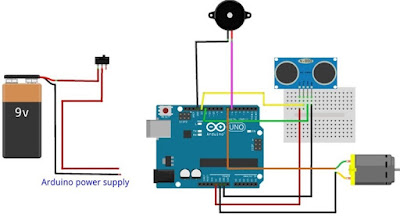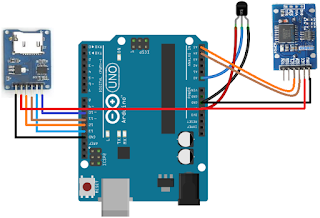المواد المطلوبة
اردوينو اونو
اردوينو اونو
شاشة 128X64 OLED
حساس DHT22 للحرارة والرطوبة
اسلاك التوصيل - لوحة الربط
في هذا المشروع ، سنقوم بعمل ميزان حرارة و مقياس رطوبة OLED من اردوينو. سوف نقرأ درجة الحرارة والرطوبة من مستشعر DHT22 ثم نعرض البيانات على شاشة OLED.
كود اردوينو
#include #include "DHT.h" #define DHTPIN 7 #define DHTTYPE DHT22 DHT sensor(DHTPIN, DHTTYPE); U8GLIB_SH1106_128X64 oled (13, 11, 10, 9, 8); void setup() { sensor.begin(); oled.firstPage(); do { oled.setFont(u8g_font_fur14); //setting the font size //Printing the data on the OLED oled.drawStr(20, 15, "Welcome"); oled.drawStr(40, 40, "To"); oled.drawStr(5, 60, "DIYHACKING"); } while( oled.nextPage() ); delay(5000); } void loop() { float h = sensor.readHumidity(); //Reading the humidity value float t = sensor.readTemperature(); //Reading the temperature value float fah = sensor.readTemperature(true); //Reading the temperature in Fahrenheit if (isnan(h) || isnan(t) || isnan(fah)) { //Checking if we are receiving the values or not Serial.println("Failed to read from DHT sensor!"); return; } float heat_index = sensor.computeHeatIndex(fah, h); //Calculating the heat index in Fahrenheit float heat_indexC = sensor.convertFtoC(heat_index); //Calculating the heat index in Celsius oled.firstPage(); do { oled.setFont(u8g_font_fub11); //setting the font size //Printing the data on the OLED oled.drawStr(0, 15, "Temp: "); oled.drawStr(0, 40, "Hum: "); oled.drawStr(0, 60, "Hi: "); oled.setPrintPos(72, 15); //setting the dimensions to print the temperature oled.print(t, 0); oled.println("C"); oled.setPrintPos(72, 40); //setting the dimensions to print the humidity oled.print(h, 0); oled.println("%"); oled.setPrintPos(72, 60); //setting the dimensions to print the heat index oled.print(heat_indexC, 0); oled.println("%"); } while( oled.nextPage() ); delay(2000); }













